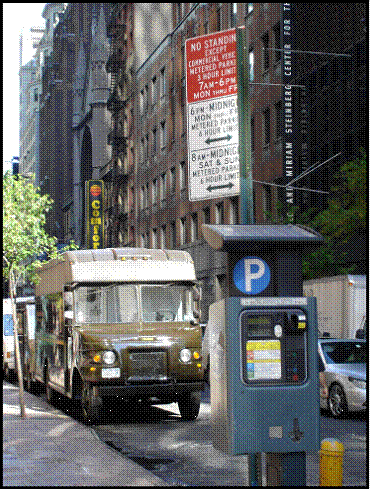| Skip
to content |
|
Urban Freight Case Studies - New York CityNOTABLE PRACTICESCurbside ManagementMidtown Manhattan is one of the nation's most active commercial centers. Many deliveries and pickups must be made to and from this thriving district by means of a physically constrained transportation system. To maintain the efficient flow of goods and services throughout this district, NYCDOT implemented several curbside management strategies indentified in its Commercial Vehicle Parking Plan. Commercial vehicles contribute to traffic congestion in Midtown Manhattan and are affected by it as well. The limited number of loading/unloading zones available, in addition to the number of vehicles using the spaces for long-term parking, has forced many trucks and other large vehicles to double-park, thereby reducing the capacity of the affected street by one lane of traffic. To improve traffic flow, the Commercial Vehicle Parking Plan recommended providing additional curbside spaces for commercial vehicles, reducing the amount of time these spaces are occupied, and increasing enforcement. By improving the management of loading/unloading zones in the Midtown area, NYCDOT decreased the number of double-parked vehicles, which resulted in a reduction in congestion. Initial implementation focused on the streets between 43rd and 59th and Fifth Avenue and Seventh Avenue. Because of the program's success, implementation was expanded to cover the streets between Second and Ninth Avenues as shown in Figure 2. Figure 2: NYCDOT Midtown Commercial Vehicle Parking Program
Source: New York City Department of Transportation, Traffic Rules (New York City, NY: 2009), chapter 4. In the newly designated commercial vehicle loading zones, New York City has replaced single-space parking meters with ticket dispensing "Muni-meters" (Figure 3). These meters, located along each block of restricted curb space, allow commercial vehicle operators to purchase prepaid parking tickets for up to three hours. Payments can be made with quarter and dollar coins or NYC Parking Cards. Some machines now accept credit cards. Figure 3: Muni-meter on New York City Street
Source: Street Smarts, New York City, NY 2006. In the past, curb spaces were reserved for commercial vehicles from 7 a.m. to 6 p.m to provide access to businesses during the busiest hours of the day. However, the allocation of these loading/unloading zones alone could not accommodate the volume of trucks that carry goods or provide services to and from the region on a daily basis. In addition, the amount of time that each vehicle was occupying a space needed to be reduced. To ensure curb-space turnover, and, therefore, increase parking availability to a larger number of users, NYCDOT implemented a pricing strategy through the Muni-meter program. An escalating rate structure of $2.00 for one hour, $5.00 for two hours and $9.00 for three hours was designed to encourage shorter dwell times. As a result, the strategy has led to a significant reduction in dwell times for curbside loading spaces. Cost/Benefits of Curbside Management ProjectsCosts related to the curbside management projects discussed above include Muni-meters, new signs, and the creation of New York City Parking Cards. These cards were not necessary, but made the transactions more convenient to commercial vehicle operators. The City anticipates that the revenue collected from the meters will eventually cover the capital costs. Some skeptics of the program have voiced concerns that a decrease in parking fines will reduce City revenues. In 2005, New York City collected $102 million in commercial vehicle parking fines.3 This accounted for 3 percent of the $18.5 billion the finance department collects each year.4 However, revenue from Muni-meters can help balance the potential loss from parking fines. In addition, other indirect costs could be avoided through the implementation of curbside management strategies. For example, increasing parking turnover rates and providing additional parking capacity can reduce the number of parking citations issued and administrative costs associated with contested tickets. On average 7,000 tickets are issued to commercial vehicles alone, and administrative costs for contested parking violations are extremely high. A 2005 initiative by the City offered reduced fines to offenders in exchange for the agreement not to contest a ticket. This agreement resulted in the elimination of 94 judges and a savings of $2,000,000 in administrative costs.5 According to NYCDOT's post-implementation studies, the curbside management program has accomplished its goal of enhanced curbside efficiency. Results show that the percentage of occupied curb space has dropped from an average of 140 percent (meaning that all spaces were occupied, with double parking occurring at 40 percent of these locations) to 95 percent. As a result of the City's curb-space pricing strategy, average duration of curbside occupancy has decreased from 160 minutes to 45 minutes and that only about 25 percent of these commercial vehicles are occupying spaces for more than one hour. With the reduction in occupancy rates and dwell times, commercial vehicles encounter less difficult locating available parking spaces and, therefore, do not have to travel around the block multiple times. Eliminating this recirculation has many benefits, including reductions in congestion, air pollution, noise, and fuel consumption. To ensure acceptance of its curbside management program, NYCDOT reaching out and providing information on benefits to commercial vehicle operators and businesses. One important benefit was the ability to deduct the cost of parking as a business expense. Parking violations cannot be deducted as an expense. 3 "Delivery firms' big ticket item: Parking Fines"; http://www.msnbc.com/id/14602712/; 09/01/2006 4 "Delivery firms' big ticket item: Parking Fines"; http://www.msnbc.com/id/14602712/; 09/01/2006 5 Jo Craven McGinty and Ralph Blumenthal, "City Will Slash That Parking Fine, If You Ask", The New York Times, January 1, 2009. |
|
United States Department of Transportation - Federal Highway Administration |
||